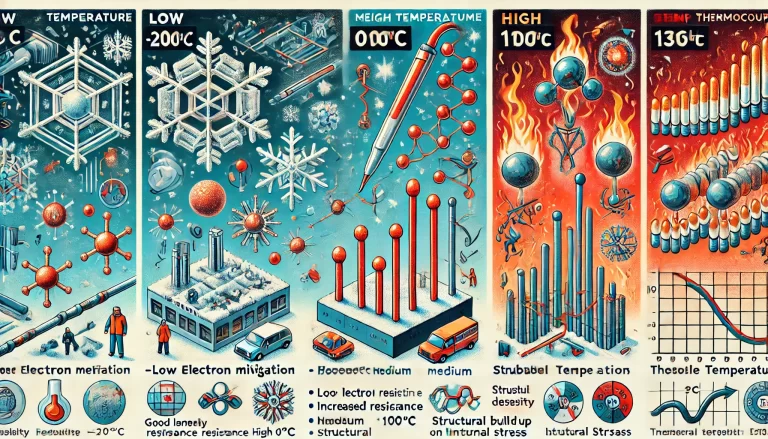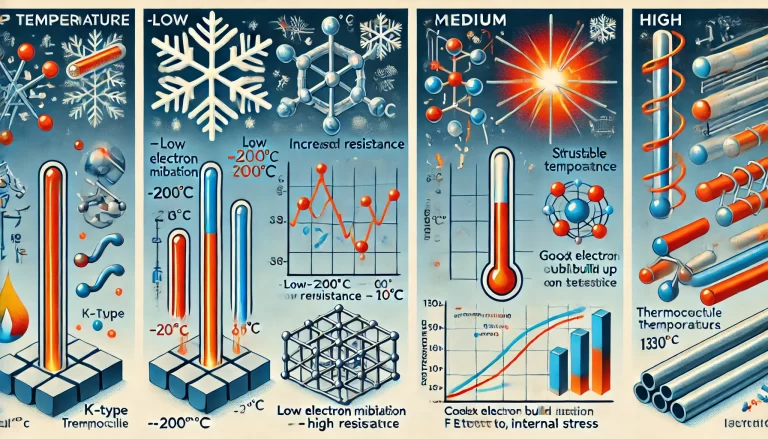K-type thermocouples are composed of Nickel-Chromium alloy (positive leg) and Nickel-Silicon alloy (negative leg). Their thermoelectric performance varies significantly with temperature. This article explores the behavior of K-type thermocouples across three typical temperature stages: low, medium, and high temperatures.
🔹 1. Low-Temperature Range (-200°C to 0°C)
1.1 Suppressed Electron Migration
At very low temperatures, atomic thermal motion is significantly reduced, inhibiting the migration of electrons. As a result, the diffusion of electrons from the Nickel-Chromium leg to the Nickel-Silicon leg is weakened, leading to low thermoelectric potential (EMF) and poor sensitivity.
1.2 Increased Electrical Resistance
According to the general behavior of metals, electrical resistance increases as temperature decreases. Both alloy legs exhibit this effect. The temperature coefficient of resistance (TCR) provides a predictable relationship, allowing indirect temperature estimation through resistance measurement.
1.3 Stable Material Properties
Within this temperature range, the crystal structures of both alloys remain stable, ensuring reliable operation. External interference is minimal, which supports consistent measurement performance in cryogenic conditions.

🔹 2. Medium-Temperature Range (0°C to 1100°C)
2.1 Good Linearity and Sensitivity
As temperature increases, electron activity intensifies, enhancing the electron diffusion between the two alloys. This results in a well-defined linear relationship between temperature and thermoelectric voltage, providing high sensitivity and accuracy for industrial applications.
2.2 Linearly Increasing Resistance
Higher temperatures increase atomic vibration, which causes more frequent electron scattering and leads to linearly increasing resistance. This behavior facilitates precise conversion of temperature changes into measurable electrical signals.
2.3 Excellent Material Stability
The oxidation resistance of the Nickel-Chromium alloy and the thermal stability of the Nickel-Silicon alloy ensure that the thermocouple remains stable during long-term operation, offering reliable and repeatable temperature readings.
🔹 3. High-Temperature Range (1100°C to 1300°C)
3.1 Complex EMF Behavior
At elevated temperatures, accelerated oxidation of chromium in the Nickel-Chromium leg leads to the formation of an oxide layer on the surface. This layer interferes with electron transport, causing nonlinear and unstable thermoelectric signals, which may degrade measurement accuracy.
3.2 Abnormal Resistance Behavior
High temperatures can induce microstructural changes such as grain growth and lattice distortion. These changes disrupt the normal resistance-temperature relationship, making resistance-based temperature estimation less reliable.
3.3 Material Degradation
Thermal expansion increases significantly at this stage. If the two alloy legs have mismatched thermal expansion coefficients, internal stress may develop, leading to deformation or damage of the thermocouple. This affects both service life and measurement accuracy.

🔧 Engineering Recommendations
For temperatures below -100°C, consider using T-type thermocouples, which are more suitable for low-temperature measurement.
When operating above 1100°C, apply protective sheaths or consider N-type thermocouples, which offer better high-temperature oxidation resistance.
Regular calibration is essential to detect performance drift caused by oxidation or material aging.
Avoid prolonged exposure to the upper temperature limit to extend the lifespan and accuracy of the sensor.
